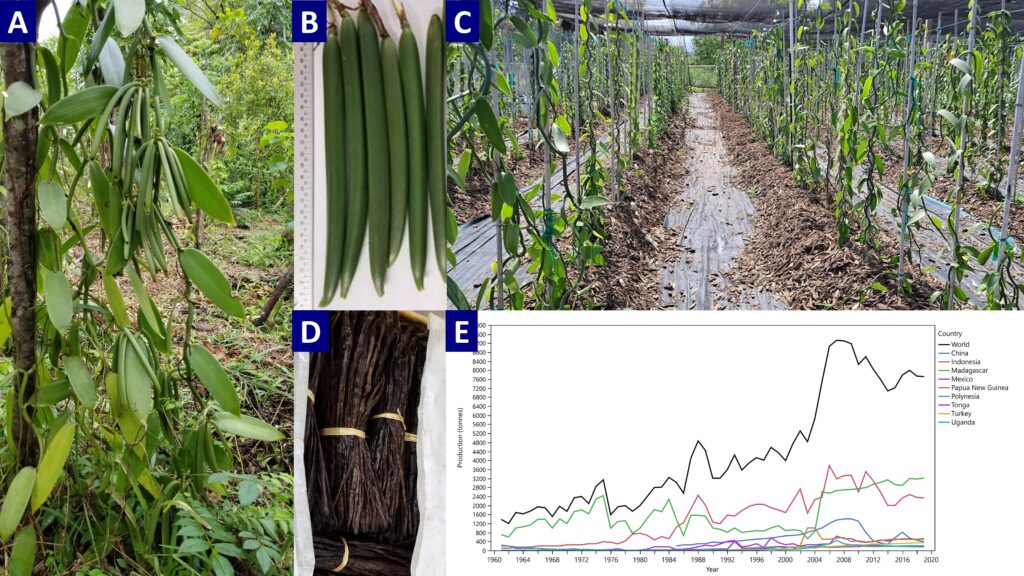Project Overview
Commodities
- Additional Plants: vanilla
Practices
- Crop Production: crop improvement and selection, varieties and cultivars
- Education and Training: participatory research
- Farm Business Management: new enterprise development
- Sustainable Communities: new business opportunities
Proposal abstract:
Vanilla is among the highest grossing agricultural commodities by weight, and could revitalize the distressed subtropical agricultural industry. The primary commercial species, V. planifolia, is native to North and Central America, but Madagascar is today’s leading vanilla producer. The United States is the largest importer of cured vanilla beans, but domestic production is currently limited. Domestic vanilla production is becoming increasingly attractive as international supplies are perennially strained and demand for vanilla extract increases as companies like MARS, Unilever, and Nestlé pledge to remove artificial ingredients from their products (ANDRIAMAHERY AND ZHOU, 2018; BROWNELL JR, 2011; TERAZONO, 2017). Growing vanilla beans has the potential to support growers in Florida, Puerto Rico, and the US Virgin Islands striving to meet an evolving consumer base favoring local, organic, and natural products (CHAMBERS, 2018; PEREZ-SILVA et al., 2006). Vanilla also encourages agroforestry and sustainability because it grows in shade and is often cultivated in an agroforestry setting. This natural habitat, combined with the beauty and exoticism of the plant, makes it attractive for agrotourism, providing an additional source of revenue for vanilla farmers and nearby rural communities. Indeed, vanilla has the potential to thrive in Florida, Puerto Rico, and the US Virgin Islands with adapted material producing gourmet-class beans (see Figure 1). Unlike most crops, vanilla has not been domesticated through plant improvement, and today’s industry relies on cultivated, wild clones (SOTO-ARENAS AND CAMERON, 2003). Little information is available about which clones are most suitable and productive for a given region and climate. The biggest challenge inhibiting domestic vanilla production has been the lack of appropriate planting material and scientifically-validated growing information. Therefore, even when vanilla reached a peak of $600/kg in 2019 (~$1.5M per acre gross value), domestic growers were not in a position to benefit from this market. Additionally, the emerging domestic vanilla market requires a supply chain to move product efficiently from farm to end users. Therefore, this project was designed to overcome these challenges and could have major impacts on productivity, profitability, and rural communities. Because of the location of the project, the farmers and communities that would benefit have a high proportion of underrepresented groups. Objectives of this project include 1) Research and development, 2) Extension and grower trials, and 3) Market development and supply chain analysis. We calculate that the USA could be the 5th largest vanilla producer globally with 140 to 670 acres devoted to this specialty crop.
Figure 1. Vanilla cultivation. A) Vanilla in an agroforestry system, B) Gourmet-class vanilla beans grown in Florida, C) A high-density, two-year-old vanillery in Homestead, FL, D) Cured vanilla beans bundled and ready for extraction, and E) Production values for the top global producers of vanilla beans.
Project objectives from proposal:
Objective 1. Research and development
1.1 Identify elite vanilla planting material from UF diversity collection including high-yielding types.
1.2 Analyze bean quality through HPLC analysis of vanilla extract.
1.3 Determine optimal shade level to accelerate vanilla plant growth in Florida.
1.4 Communicate results through peer-reviewed publications, public seminars, and grower documents.
Objective 2. Extension and grower trials
2.1 Propagate selected plant material and distribute to grower cooperators
2.2 Distribute growing information to social disadvantaged grower cooperators in English and Spanish
2.3 Collect data from grower plots
2.4 Organize grower field days, symposia, virtual seminars
Objective 3. Analyze market and supply chain development
3.1 Advance farm-to-business activities through pilot projects
3.2 Conduct market analyses
3.3 Hold participatory workshops, facilitate networking events, and establish pilot projects
